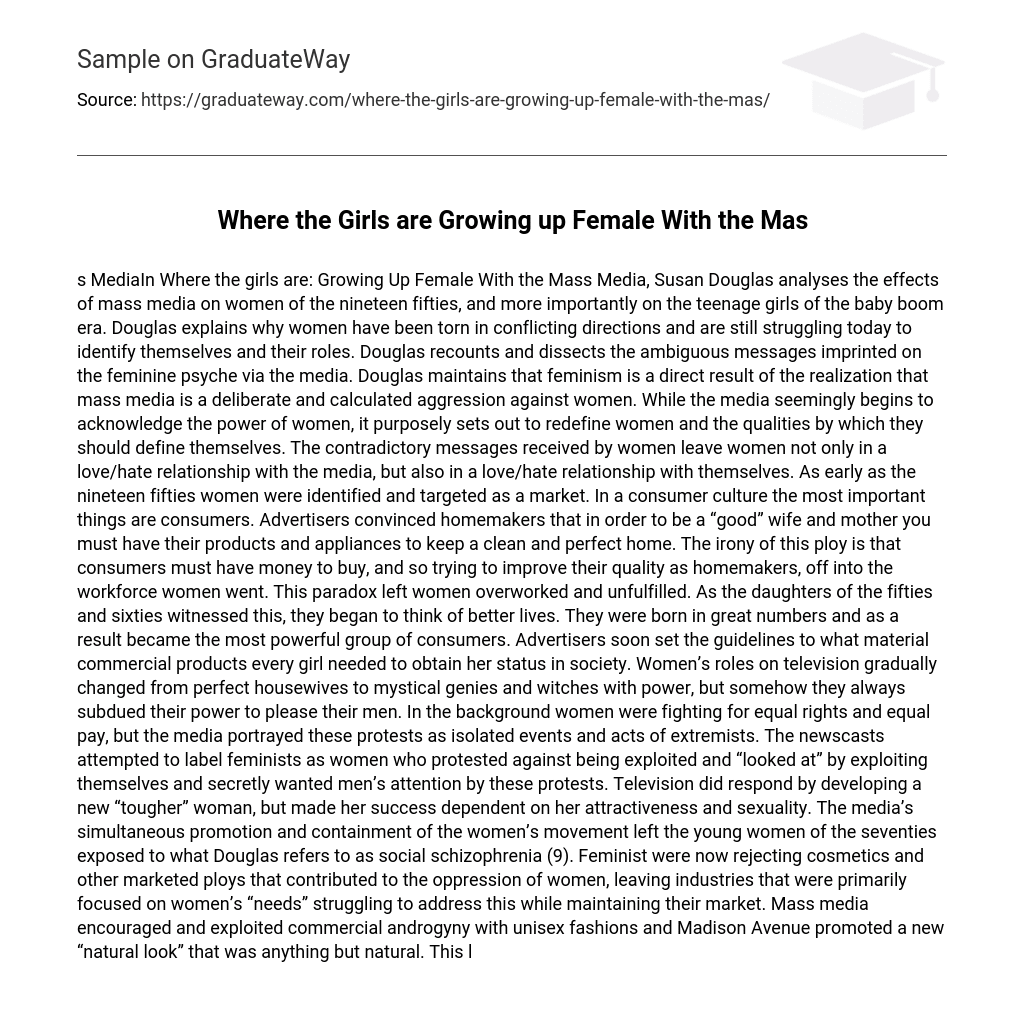In her analysis, Douglas explores the impact of mass media on women in the 1950s, particularly teenage girls during the baby boom. She discusses the challenges women faced in reconciling conflicting expectations and the ongoing struggle to define their identities and roles. Douglas examines the mixed messages embedded in the female psyche through media representation. Ultimately, she argues that feminism emerged in response to the realization that mass media intentionally and systematically undermines women.
Although the media appears to be recognizing the influence of women, it intentionally seeks to redefine women and the characteristics by which they should identify themselves. These conflicting messages received by women lead them to have mixed feelings about both the media and themselves. As far back as the 1950s, women were identified and targeted as a demographic. In a society centered around consumption, consumers hold the utmost importance. Advertisers successfully persuaded housewives that to be considered a “good” wife and mother, they must possess their products and appliances to maintain a pristine and flawless household.
The irony of this strategy is that women had to enter the workforce to improve their homemaking skills, even though they needed money to buy products. This contradiction led to women becoming overworked and unsatisfied. As the daughters of the fifties and sixties observed this situation, they started envisioning better lives for themselves. Being born in large numbers, they became a significant consumer group with immense power. Advertisers quickly established the standards for the commercial items that every girl needed to possess in order to achieve her societal status.
Over time, women’s portrayals on television shifted from being ideal homemakers to having mystical abilities like genies and witches. However, they consistently suppressed these powers in order to satisfy their male counterparts. Concurrently, women were advocating for equal rights and pay in the background. Regrettably, the media often depicted these protests as isolated incidents led by extremists.
The newscasts aimed to portray feminists as women who protested against being exploited and objectified, while paradoxically exploiting themselves and desiring male attention through these protests. Television responded by creating a new kind of woman, who was strong and resilient, but her success was contingent on her beauty and sexuality. This contradictory support and restriction by the media towards the women’s movement left young women in the seventies vulnerable to what Douglas describes as social schizophrenia.
Feminists started to reject cosmetics and other marketing tactics that contributed to the oppression of women. As a result, industries that primarily targeted women’s “needs” had difficulty addressing this issue while trying to maintain their market share. The mass media encouraged and took advantage of commercial androgyny by promoting unisex fashion trends, while Madison Avenue promoted a new “natural look” that was far from natural. This look promoted a Lolita image that treated women as children and encouraged them to seek attractiveness and approval from men.
Despite attempts by television shows and advertisers to confine women’s self-improvement to personal and narcissistic domains, they continue to convey the message that women should adhere to specific standards of appearance, attire, and behavior. Present-day women remain susceptible to the influence of advertisers, societal expectations, and the agendas dictated by mass media. Caught between their professional aspirations and motherhood, marriage and autonomy, women constantly face ideals presented by anorexic models that they are expected to measure themselves against. They are challenged to be both sexy and virginal, making them perpetual victims, though paradoxically embracing their feminine existence. Susan Douglas contends that although women are still vulnerable to media manipulation and feel the guilt of not living up to these standards, awareness of this manipulation may alleviate the pressure and guide them towards their authentic selves.





